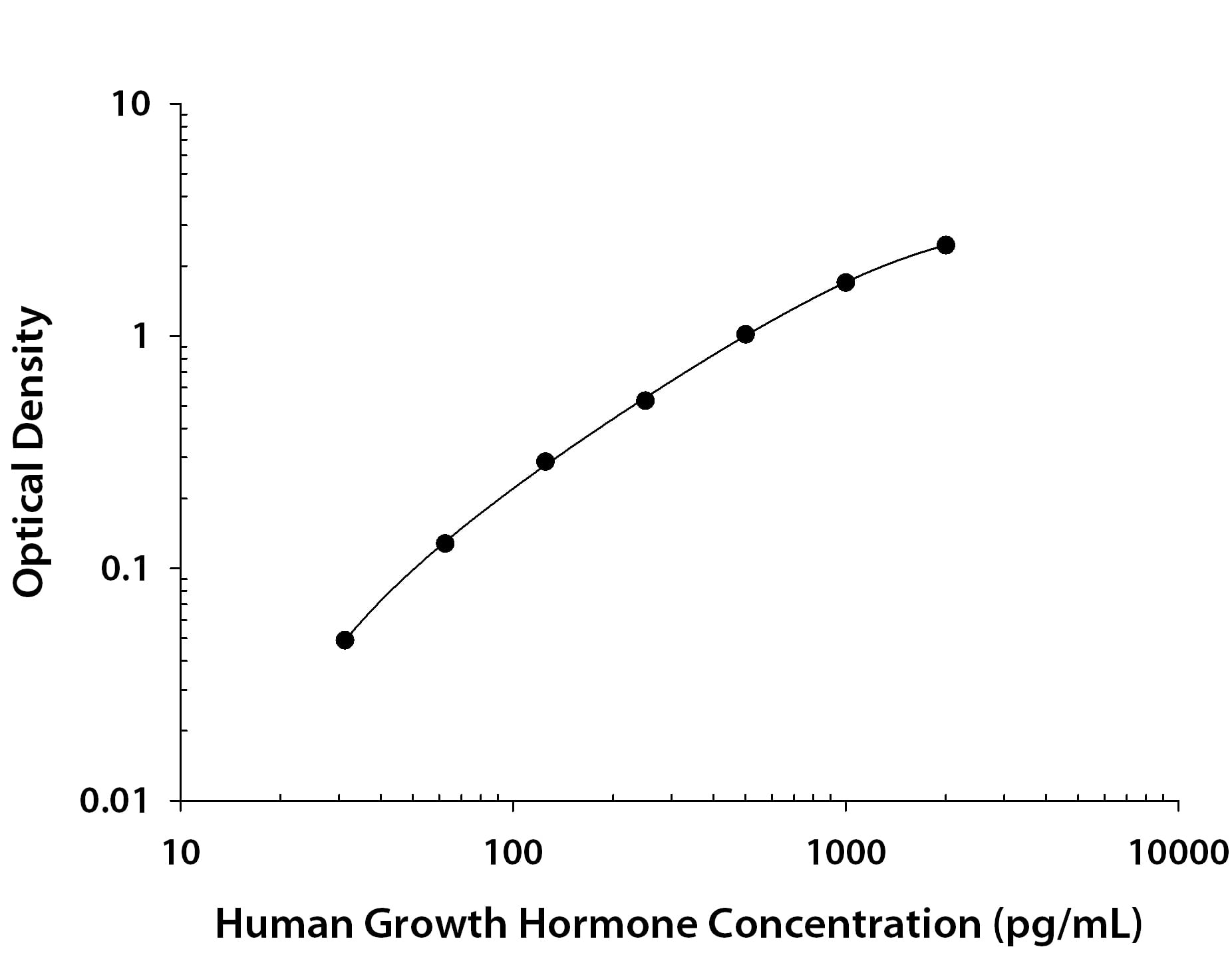Human Growth Hormone Antibody
R&D Systems, part of Bio-Techne | Catalog # MAB10671

Key Product Details
Species Reactivity
Validated:
Cited:
Applications
Validated:
Cited:
Label
Antibody Source
Product Specifications
Immunogen
Phe27-Phe217
Accession # CAA23779
Specificity
Clonality
Host
Isotype
Scientific Data Images for Human Growth Hormone Antibody
Human Growth Hormone ELISA Standard Curve.
Recombinant Human Growth Hormone protein was serially diluted 2-fold and captured by Mouse Anti-Human Growth Hormone Monoclonal Antibody (Catalog # MAB10671) coated on a Clear Polystyrene Microplate (Catalog # DY990). Goat Anti-Human/Mouse/Rat Growth Hormone Antigen Affinity-purified Polyclonal Antibody (Catalog # AF1067) was biotinylated and incubated with the protein captured on the plate. Detection of the standard curve was achieved by incubating Streptavidin-HRP (Catalog # DY998) followed by Substrate Solution (Catalog # DY999) and stopping the enzymatic reaction with Stop Solution (Catalog # DY994).Applications for Human Growth Hormone Antibody
ELISA
This antibody functions as an ELISA capture antibody when paired with Goat Anti-Human/Mouse/Rat Growth Hormone Antigen Affinity-purified Polyclonal Antibody (Catalog # AF1067).
This product is intended for assay development on various assay platforms requiring antibody pairs. We recommend the Human Growth Hormone (GH) DuoSet ELISA Kit (Catalog # DY1067) for convenient development of a sandwich ELISA or the Human Growth Hormone Quantikine ELISA Kit (Catalog # DGH00) for a complete optimized ELISA.
Formulation, Preparation, and Storage
Purification
Reconstitution
Formulation
Shipping
Stability & Storage
- 12 months from date of receipt, -20 to -70 °C as supplied.
- 1 month, 2 to 8 °C under sterile conditions after reconstitution.
- 6 months, -20 to -70 °C under sterile conditions after reconstitution.
Background: Growth Hormone
Growth hormone (GH), also known as somatotropin, is a member of a family of growth factors that includes prolactin, placental lactogens, proliferins, and somatolactin (1, 2). It is synthesized primarily by somatotropes in the anterior pituitary and is stored in secretary granules. The pulsatile release of GH into circulation is regulated by the concerted actions of the hypothalamic hormones, GH-releasing hormone (GHRH) and somatostatin (SST), as well as by signals from the periphery, ghrelin (3) and leptin (4). The human GH cDNA encodes a 217 amino acid (aa) precursor protein with a 26 aa putative signal peptide. By alternative splicing, at least four isoforms of GH have been identified (5). Human GH is a pleiotropic cytokine that exerts its biological actions by binding to the transmembrane GH receptor, which is present in many cell types (1, 2). GH stimulates the liver and other tissues to produce IGF-I, which regulates growth and metabolism. GH has also been shown to have direct effects on growth that is independent of IGF-I. GH, directly or indirectly via IGF-I, can act on B cells, T cells, NK cells, macrophages, and neutrophils to exert immunomodulatory activities (6). In addition, GH can act directly on various cell types to induce lipolysis, lactation, amino acid uptake, and protein synthesis (1, 2, 6).
References
- Goffin, V. et al. (1996) Endocrine Rev. 17:385.
- Le Roith, D. et al. (2001) Endocrine Rev. 22:53.
- Kojima, K. et al. (1999) Nature 402:656.
- Tannenbaum, G. et al. (1998) Endocrinol. 139:3871.
- Welniak, L.A. et al. (2002) J. Leukoc. Biol. 71:381.
Alternate Names
Entrez Gene IDs
Gene Symbol
UniProt
Additional Growth Hormone Products
Product Documents for Human Growth Hormone Antibody
Product Specific Notices for Human Growth Hormone Antibody
For research use only
